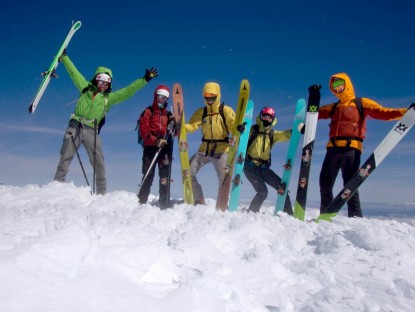Along with new graphics, G3 gave the FINDr 102 some magnetic contact points, meant to eliminate the need to use straps to keep the skis together when carrying. The photo above shows the updated ski.
November 2019G3 FINDr 102 Review
Our Verdict
Our Analysis and Test Results
The G3 Findr 102 is a mid-fat ski with relatively light construction and design. It has been available for many seasons now and has a number of favorable reviews elsewhere on the web. The result is an appealing human-powered “all-around” ski that we found to have serious limitations for true all-around use. If your season and runs include true firm snow, these aren't an excellent choice for your “quiver of one”. If you can stick to mainly soft snow, these can be a durable and reliable choice.
Performance Comparison
Weight
In absolute terms, the Findr 102 is one of the heavier skis we reviewed. The pair we tested (in 184cm length) weighs 7.1 pounds for the pair. The catch is, we like lightweight skis in this review category. Backcountry skiing is human-powered skiing, and human-powered skiing is better with light gear. We filter our selections by lighter gear; therefore, the Findr appears heavy in this review. The truth is, though, that as compared to older skis and alpine skis, these are ultralight. Also, as compared to other skis of this width, these are ultralight. In our “weight per surface area” calculations, the Findr does a lot better, by comparison.
When we calculate the weight per surface area of all our skis, the 102 is right in the mix with our Editors' Choice winner and with other great skis. In absolute terms, though, the Findr is noticeably heavier than these other two. Of course, the Top Pick choices are way different than the Findr 102. The big gun Top Pick is almost a full pound heavier than the Findr, while the ultralight Top Pick is better than two pounds less. The range of available ski weights on the market is large. Among dedicated backcountry skis, the 102 is a little above average.
Stability at Speed
Skiing is kinetic, and we like skis that can hang at speed. Touring skis cannot always do this very well. There is certainly a range of performance in this category. In wide open Teton Pass bowls, we were able to let 'em run and assess our confidence in a variety of conditions. Similarly, on a rare in-bounds day, our lead tester took 'em for a ride. Our experience with the 102 is a cautionary tale for those that want to rely on construction attributes for their assessment of ski performance. “By the numbers”, and given the materials used, we might expect the 102 to be quite stable. For some reason, though, our experience was of a twitchy, grabby, scary ski. We simply couldn't count on the stability of these like we could others. Even after days of testing (and associated familiarization), the Findr was not confidence-inspiring to our test team.
Firm Snow
These are skis for soft snow. If firm snow is anything more than a passing lark in your ski life, choose something else. On a rock-hard, cold day in the Tetons, we eagerly anticipated the return to the car, as the Findr 102 felt downright dangerous. Further testing, under other skiers, verified this experience. Even G3 hedges their bets when they describe the Findr. The first line of their catalog copy indicates that the Findr 102 is built to bridge “the gap between fat, floaty powder skis and super light mountaineering skis”. They go on to both claim that the Findr 102 is “built to excel in… hard and mixed snow” and to recommend that users that encounter more hard stuff than soft stuff choose narrower skis. We agree with this final tip. Narrower than 102mm, especially when the construction is light, is better for firm snow.
In short, our experience with the Findr 102 on ice was that it just wouldn't grab with any sort of tenacity or predictability. It felt as though only the middle third of the edge length was grabbing at all.
Powder
This is what we live for, and this is what the Findr is made for. Once you are accustomed to the technical inputs required of the Findr 102, skiing thousands of feet of powder, up and down, is what these are made for. They float reliably, snap from one turn to the next, and track straight and predictably. We never buried a tip nor had a ski wander off on us in thousands of feet of Teton pow. These prefer short, snappy powder turns more than fast and high radius riding.
Crud/Poor Snow
If, overall, the downhill performance of the Findr is underwhelming, we've been pleased with the poor snow performance. The shape, mass, and materials seem to work together to bring both ski tips up out of breakable crust, in parallel, and without errant moves. This is a tall order.
Value
At retail, these skis are about middle of the road. Three seasons now of production means that there are deals to be had out there.
Conclusion
They are not our favorite skis of all time, by any means. For soft snow, human-powered riding by skiers with high-end technique and patience to adapt to some demands, the Findr has a place. Stacked up against our select list of very excellent skis, the G3 Findr 102 suffers a little bit. That being said, compared to the entire market and the skis of just a few years ago, the Findr is excellent. For the price and availability, especially if you value supporting North American companies and manufacturing, they are worth your investigation.









